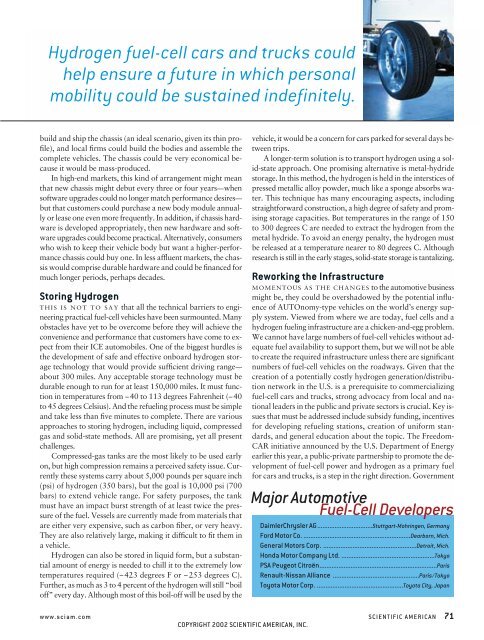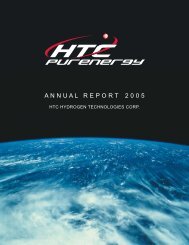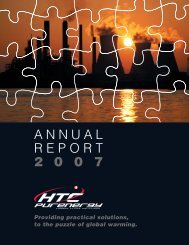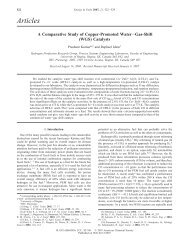Scientific American.pdf
Scientific American.pdf
Scientific American.pdf
You also want an ePaper? Increase the reach of your titles
YUMPU automatically turns print PDFs into web optimized ePapers that Google loves.
Hydrogen fuel-cell cars and trucks could<br />
help ensure a future in which personal<br />
mobility could be sustained indefinitely.<br />
build and ship the chassis (an ideal scenario, given its thin profile),<br />
and local firms could build the bodies and assemble the<br />
complete vehicles. The chassis could be very economical because<br />
it would be mass-produced.<br />
In high-end markets, this kind of arrangement might mean<br />
that new chassis might debut every three or four years—when<br />
software upgrades could no longer match performance desires—<br />
but that customers could purchase a new body module annually<br />
or lease one even more frequently. In addition, if chassis hardware<br />
is developed appropriately, then new hardware and software<br />
upgrades could become practical. Alternatively, consumers<br />
who wish to keep their vehicle body but want a higher-performance<br />
chassis could buy one. In less affluent markets, the chassis<br />
would comprise durable hardware and could be financed for<br />
much longer periods, perhaps decades.<br />
Storing Hydrogen<br />
THIS IS NOT TO SAY that all the technical barriers to engineering<br />
practical fuel-cell vehicles have been surmounted. Many<br />
obstacles have yet to be overcome before they will achieve the<br />
convenience and performance that customers have come to expect<br />
from their ICE automobiles. One of the biggest hurdles is<br />
the development of safe and effective onboard hydrogen storage<br />
technology that would provide sufficient driving range—<br />
about 300 miles. Any acceptable storage technology must be<br />
durable enough to run for at least 150,000 miles. It must function<br />
in temperatures from −40 to 113 degrees Fahrenheit (−40<br />
to 45 degrees Celsius). And the refueling process must be simple<br />
and take less than five minutes to complete. There are various<br />
approaches to storing hydrogen, including liquid, compressed<br />
gas and solid-state methods. All are promising, yet all present<br />
challenges.<br />
Compressed-gas tanks are the most likely to be used early<br />
on, but high compression remains a perceived safety issue. Currently<br />
these systems carry about 5,000 pounds per square inch<br />
(psi) of hydrogen (350 bars), but the goal is 10,000 psi (700<br />
bars) to extend vehicle range. For safety purposes, the tank<br />
must have an impact burst strength of at least twice the pressure<br />
of the fuel. Vessels are currently made from materials that<br />
are either very expensive, such as carbon fiber, or very heavy.<br />
They are also relatively large, making it difficult to fit them in<br />
a vehicle.<br />
Hydrogen can also be stored in liquid form, but a substantial<br />
amount of energy is needed to chill it to the extremely low<br />
temperatures required (−423 degrees F or −253 degrees C).<br />
Further, as much as 3 to 4 percent of the hydrogen will still “boil<br />
off” every day. Although most of this boil-off will be used by the<br />
vehicle, it would be a concern for cars parked for several days between<br />
trips.<br />
A longer-term solution is to transport hydrogen using a solid-state<br />
approach. One promising alternative is metal-hydride<br />
storage. In this method, the hydrogen is held in the interstices of<br />
pressed metallic alloy powder, much like a sponge absorbs water.<br />
This technique has many encouraging aspects, including<br />
straightforward construction, a high degree of safety and promising<br />
storage capacities. But temperatures in the range of 150<br />
to 300 degrees C are needed to extract the hydrogen from the<br />
metal hydride. To avoid an energy penalty, the hydrogen must<br />
be released at a temperature nearer to 80 degrees C. Although<br />
research is still in the early stages, solid-state storage is tantalizing.<br />
Reworking the Infrastructure<br />
MOMENTOUS AS THE CHANGES to the automotive business<br />
might be, they could be overshadowed by the potential influence<br />
of AUTOnomy-type vehicles on the world’s energy supply<br />
system. Viewed from where we are today, fuel cells and a<br />
hydrogen fueling infrastructure are a chicken-and-egg problem.<br />
We cannot have large numbers of fuel-cell vehicles without adequate<br />
fuel availability to support them, but we will not be able<br />
to create the required infrastructure unless there are significant<br />
numbers of fuel-cell vehicles on the roadways. Given that the<br />
creation of a potentially costly hydrogen generation/distribution<br />
network in the U.S. is a prerequisite to commercializing<br />
fuel-cell cars and trucks, strong advocacy from local and national<br />
leaders in the public and private sectors is crucial. Key issues<br />
that must be addressed include subsidy funding, incentives<br />
for developing refueling stations, creation of uniform standards,<br />
and general education about the topic. The Freedom-<br />
CAR initiative announced by the U.S. Department of Energy<br />
earlier this year, a public-private partnership to promote the development<br />
of fuel-cell power and hydrogen as a primary fuel<br />
for cars and trucks, is a step in the right direction. Government<br />
Major Automotive<br />
Fuel-Cell Developers<br />
DaimlerChrysler AG................................Stuttgart-Mohringen, Germany<br />
Ford Motor Co. ..............................................................Dearborn, Mich.<br />
General Motors Corp. ......................................................Detroit, Mich.<br />
Honda Motor Company Ltd. ......................................................Tokyo<br />
PSA Peugeot Citroën....................................................................Paris<br />
Renault-Nissan Alliance ..................................................Paris/Tokyo<br />
Toyota Motor Corp. ..................................................Toyota City, Japan<br />
www.sciam.com SCIENTIFIC AMERICAN 71<br />
COPYRIGHT 2002 SCIENTIFIC AMERICAN, INC.






